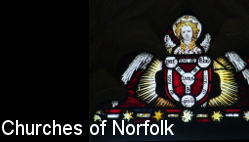| |
|
St
Nicholas, Bracon Ash The two
lovely churches of Bracon Ash and Hethel sit barely a
mile apart in the fields and woods of South Norfolk. Both
churches are open every day, so the lucky people around
here can step into their numinous spaces whenever they
want to, and more importantly whenever they need to. I
first came here on a bitter day in mid-winter, the
bone-cold January of 2006, and I would not come back for
ten years. By then it was in the warmth of one of
Norfolk's sudden springs, the catkins bursting into life,
the brooks gurgling, the trees coming into leaf like
something almost being said..., and to be here again
in the high summer of 2021 was the very heaven, the south
side of the churchyard given over to a verdant nature
conservation area, a bastion of biodiversity against the
monoculture of the barley fields.
The settlement of Bracon Ash, like its neighbour Hethel,
is a scattering of houses through a wide parish rather
than a real village centre, and the unassuming church of
St Nicholas sits on a winding road backed by fields and
copses. There is no tower, and probably never was. Until
about a century ago there was a bellcote, but since this
fell the bell has been rung in a frame to the south of
the nave. From the north, the most striking feature is
the 18th Century Berney mausoleum built against the wall
of the chancel. This has a large portico that mimics an
entrance, with a porthole-like round window. This in turn
is echoed by blind windows to east and west. The actual
entrance to the mausoleum is inside, as we shall see.
On the south side is an elegant aisle with its own
pitched roof. This is something of a curiosity, because
the windows appear to predate the arcade, but Pevsner
suggests that a bequest of the 1370s may account for
both, the first late in style and the second early. You
step inside to an interior that is satisfying and
harmonious, Early English and early Perpendicular coming
together on a small scale. Although there was a
considerable 19th Century restoration it was rustic in
character, retaining brick floors and with simple
furnishings. Pale pastel walls add to the sense of an
18th Century space.
Complete Early English work is rare in Norfolk. The
chancel here is not wholly complete, but the arching and
hood moulding along the north and south walls are enough
to show you what was here once. That on the north side
has been disrupted for the entrance to the Berney
mausoleum, and even before the Berneys came along there
was already a large early 16th Century memorial, and
although only the frame of this survives it is so like
the Bedingfield monument at Oxborough it is probably by
the same hand. Richly detailed, it is an example of what
would have happened to English church architecture after
Perpendicular, if the Reformation had not come along.
And so, to the mausoleum. This is fascinating, if rather
macabre. Unlike the kind of 'mausoleum' you so often find
in a parish church, a room lined with grand monuments to
the dead and with a family pew for the living, this is
the real thing. On either side of a central corridor
there are lines of coffin holes. Those to the east are
now all full, with many remaining on the west side. As
each hole was filled it was sealed with an inscribed
slate slab, but there is no intention of disguising what
is actually going on. It is worth coming to see.
Simon Knott, August 2021
Follow these journeys as they happen at Last Of England
Twitter.
|
|
|
